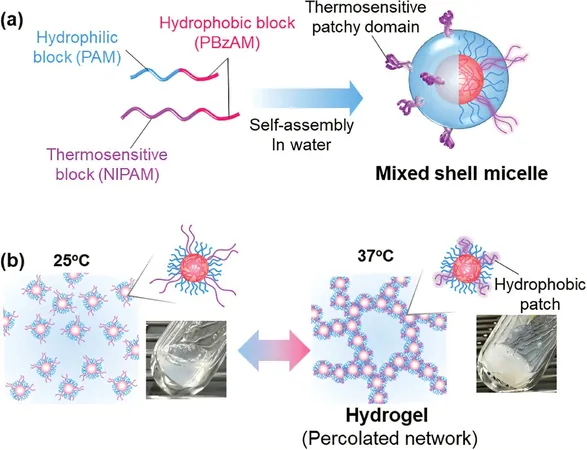
Revolutionary Thermogels Pave the Way for Next-Gen Biomedical Solutions!
2025-04-09
Author: Rajesh
Groundbreaking Bio-Materials Transforming Medical Treatments
Imagine a world where injuries heal faster and drug delivery becomes a breeze! Scientists at Penn State have unveiled a new generation of materials known as thermogels, which can be injected as a liquid and transform into solid forms right inside our bodies. This innovation promises to redefine how we approach drug delivery and wound care.
What Are Thermogels?
Thermogels are remarkable materials designed to shift from a liquid state to a gel when exposed to body temperature. This proof-of-concept study, published in the journal *Advanced Functional Materials*, has revealed groundbreaking potential for these gels in the realm of biomedical applications.
Injection, Not Incision: A Safer Alternative!
Instead of opting for invasive surgeries, patients might soon benefit from simple injections. However, controlling the formation of these hydrogels inside the body has proved challenging, often resulting in weak and unstable structures.
The Innovative "Patchy" Approach
Enter the team's new design: "patchy" nanoparticle-based thermogels. By introducing sticky spots that help nanoparticles assemble more effectively upon heating, researchers have enhanced mechanical properties and laid the groundwork for tailoring these materials across a variety of biomedical applications.
Urara Hasegawa, the study's lead author and assistant professor at Penn State, expressed excitement over this innovation: "This new approach tackles the challenges of controlling thermogel formation and can significantly influence the future of biomaterial development."
Why Stickiness Matters!
Typically, these biomedical thermogels comprise micelles—tiny spherical structures designed to transport drugs while preventing premature breakdown in the body. However, controlling their aggregation into solid forms can be a daunting task.
Hasegawa elaborated, "If every particle is sticky, they tend to clump together into defect-ridden, brittle structures. Our goal is to utilize these particles as building blocks to form orderly structures instead."
The Magic of Sticky Patches!
The innovation lies in the newly developed patchy micelles, which feature strategically placed sticky 'arms' that facilitate connection without defects. By adjusting the number of these sticky patches, scientists can precisely control the structure and mechanical properties of the thermogels.
Applications in Tissue Reconstruction and Beyond!
This breakthrough holds particular promise for soft tissue reconstruction, such as after cancer surgeries, as thermogels can serve as scaffolds—providing the essential framework for healthy tissue regeneration. Hasegawa highlights, "Imagine needing an implant without traditional surgery! Our injectable solution could significantly minimize infection risks, especially for vulnerable patients."
What’s Next for Thermogels?
While the future looks bright, further research is essential to explore the effectiveness of these innovative materials in living biological systems. The medical community may be on the brink of a new era, where injection-based treatments could lead to faster, safer recoveries for countless patients.





 Brasil (PT)
Brasil (PT)
 Canada (EN)
Canada (EN)
 Chile (ES)
Chile (ES)
 Česko (CS)
Česko (CS)
 대한민국 (KO)
대한민국 (KO)
 España (ES)
España (ES)
 France (FR)
France (FR)
 Hong Kong (EN)
Hong Kong (EN)
 Italia (IT)
Italia (IT)
 日本 (JA)
日本 (JA)
 Magyarország (HU)
Magyarország (HU)
 Norge (NO)
Norge (NO)
 Polska (PL)
Polska (PL)
 Schweiz (DE)
Schweiz (DE)
 Singapore (EN)
Singapore (EN)
 Sverige (SV)
Sverige (SV)
 Suomi (FI)
Suomi (FI)
 Türkiye (TR)
Türkiye (TR)
 الإمارات العربية المتحدة (AR)
الإمارات العربية المتحدة (AR)